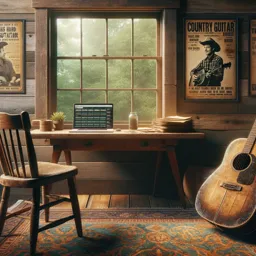Introduction:
Learning to play the blues guitar is one of the most rewarding ways to start your musical journey. The blues is built on simple structures that are easy to pick up but offer endless room for improvisation and personal expression. In this article, we’ll cover essential chords and scales that every beginner blues guitarist should know to start playing classic blues progressions and riffs.
The 12-Bar Blues Progression
At the heart of most blues music is the 12-bar blues progression, a chord sequence that forms the backbone of countless blues songs. The 12-bar blues is typically played using three chords, known as the I, IV, and V chords.
- I-IV-V Progression: In the key of E, for example, the I chord would be E, the IV chord would be A, and the V chord would be B. These chords are played in the following pattern over 12 bars (or measures):
- 4 bars of the I chord (E)
- 2 bars of the IV chord (A)
- 2 bars of the I chord (E)
- 1 bar of the V chord (B)
- 1 bar of the IV chord (A)
- 2 bars of the I chord (E)
This progression can be played in many keys, and once you master it, you’ll be able to play along with countless blues songs.
Essential Blues Chords
While the 12-bar progression provides the structure, blues chords give the music its unique character. One of the most commonly used types of chords in blues is the dominant seventh chord.
- Dominant Seventh Chords: The 7th chords add a bit of tension and flavor to blues music. For example:
- E7: A common chord in the key of E, played by adding the 7th note to a regular E major chord.
- A7 and B7: These 7th chords are typically used in the IV and V positions of the 12-bar blues in the key of E.
- Power Chords: Power chords are simple two-note chords that consist of the root note and the fifth. They are commonly used in blues and rock to add punch to the rhythm.
Blues Scales for Soloing
Blues guitar is famous for its solos, and learning the blues scale is essential for any aspiring blues guitarist. The blues scale is based on the minor pentatonic scale, with one added note—the “blue” note, which gives it that distinctive bluesy sound.
- Minor Pentatonic Scale: In the key of E, the minor pentatonic scale consists of the notes E, G, A, B, D. These five notes form the foundation of most blues solos.
- Blues Scale: The blues scale adds the flattened fifth (the blue note) to the minor pentatonic scale. In the key of E, the blues scale would be E, G, A, Bb, B, D. This additional note is often used to create tension in solos.
Bending, Sliding, and Vibrato
Blues guitar is not just about the notes you play but how you play them. Techniques like bending, sliding, and vibrato are essential for expressing emotion in blues solos.
- String Bending: Bending involves pushing or pulling a string to raise the pitch of the note. It’s often used to “sing” or add vocal-like expression to guitar solos.
- Slides: Sliding from one note to another is a technique that adds fluidity to your playing. Sliding between notes in the blues scale creates a smooth transition and gives the solo a more legato feel.
- Vibrato: Vibrato is the rapid variation of pitch around a note, adding a wavering sound. In blues guitar, vibrato is often used at the end of a note to sustain and intensify the emotion of the solo.
Conclusion:
Playing blues guitar starts with mastering the basics: the 12-bar blues progression, dominant seventh chords, and the blues scale. Once you’ve got these elements down, you’ll be able to improvise and solo with the expressive techniques that make the blues such a powerful and emotional style of music. With practice and dedication, you can begin crafting your own bluesy riffs and solos, joining the long tradition of blues guitarists before you.


























